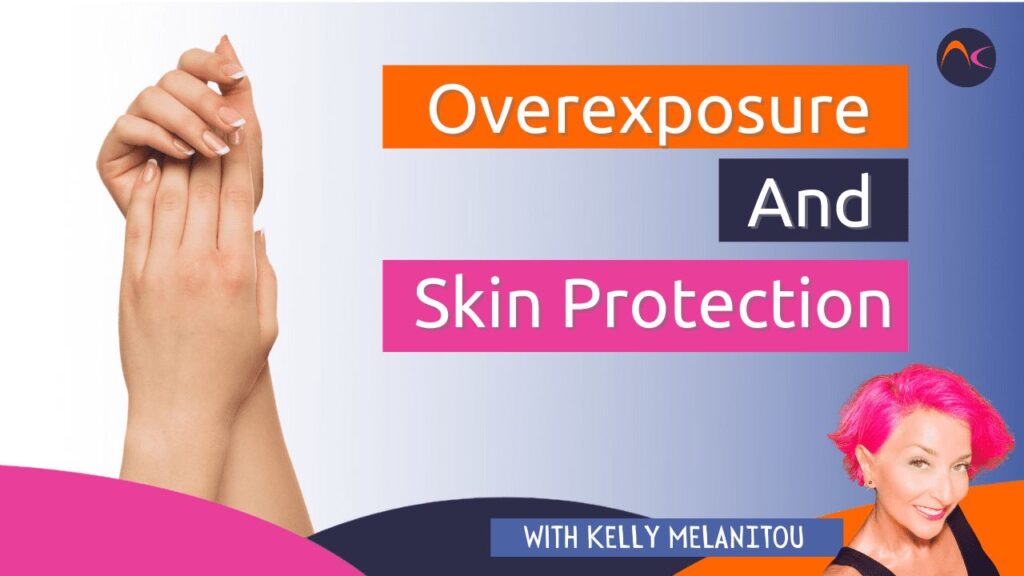I was browsing through social media last night and, somehow, I ended up watching a bunch of nail-related videos. I was shocked by how many times I saw product touching (or liberally being applied on) skin. And I am talking about products that should not be touching the skin at all, like UV gel, monomer liquid, etc. So today we are going to talk about overexposure and skin protection.
¿Qué es la sobreexposición?
Overexposure is prolonged (lingering) and/or repeated skin contact with such ingredients. Typically, products used in the nail salon are designed for application to the nail plate only. Nail professionals should understand and follow manufacturer’s guidelines to help avoid overexposing their skin and the skin of their clients. Some examples of nail products that may be potentially irritating include nail hardeners, adhesives, nail treatments, polishes, primers, as well as all types of UV gels, l&p, and resins. These are all designed to be applied to the natural nail ONLY. Skin contact should be avoided, since it may potentially cause skin irritation or allergy. That means that the skin may become red, swollen, dry, itchy, cracked, or even develop tiny water blisters.
Sometimes, we can see reactions from overexposure to things that we don’t even think about. For example, latex gloves can cause skin allergies. Overexposure (prolonged and repeated contact) to latex gloves for several months, or even years, can cause previously unaffected people to develop a persistent rash on the hands and wrists. In this case, sensitization is caused by naturally occurring proteins found in latex rubber that are acting as allergens.
La protección de la piel es importante
La forma más importante de evitar la sobreexposición es lavarse las manos. Tanto el profesional de uñas como el cliente deben lavarse las manos antes y después de cada servicio. Lávese las manos correctamente frotándolas durante al menos 20 segundos con un cepillo de cerdas suaves y jabón líquido suave, enjuagándolas bien con agua tibia y secándolas a fondo. Permitir que el polvo, las sustancias pegajosas, etc. permanezcan en la piel durante periodos prolongados puede aumentar el riesgo de desarrollar irritación cutánea o alergia. Si se derrama algún producto sobre la ropa, debe quitársela inmediatamente para evitar un contacto prolongado con la piel subyacente.
The proper glove is another important way to protect the skin. I have already mentioned that many people develop allergies to latex. Additionally, latex and vinyl gloves are more permeable to many of the ingredients used in nail products. I believe that disposable nitrile gloves are the best choice for nail pros. And if someone is allergic to cornstarch, they should avoid powdered gloves. It is interesting to know that the FDA (the US Food and Drug Administration) actually banned powdered gloves since January 2017!
¿Qué más podemos hacer?
We need to remember that we want to protect not only our clients but also ourselves from overexposure. We should avoid exposing hands to harsh cleaners, solvents, or disinfectants. These remove the natural oils from the skin, which leads to dryness. Skin that is dry or irritated becomes more susceptible to penetration of ingredients that would normally be unable to pass through the natural barrier of the skin’s surface.
Es igualmente importante mantener limpios los recipientes, las mesas, la ropa, las herramientas y los utensilios. Un recipiente con fugas o un mango de cepillo contaminado pueden provocar una exposición repetida de la piel con cada manipulación. Los tableros o las toallas contaminados con residuos de producto o polvo también pueden ser una fuente de sobreexposición. ¿Recuerda esa toalla de papel en la que se limpia el pincel cuando trabaja con l&p? Asegúrese de mantenerla alejada de su piel.
So let’s summarize:
- Haga que su cliente se lave bien las manos antes y después de cada servicio, o si se produce una exposición accidental de la piel, y haga usted lo mismo.
- Utilice guantes desechables de nitrilo o del tipo recomendado por el fabricante de los productos que utilice. Sustituya estos guantes inmediatamente si hay signos de cortes, desgarros, agujeros o contaminación.
- Elige ropa que cubra y proteja tanta piel como sea posible, como blusas ajustadas de manga larga y pantalones o faldas que lleguen al menos hasta la rodilla para protegerte el regazo.
- Mantenga los productos en recipientes de pequeño tamaño en la mesa de trabajo para reducir el riesgo de derrames y minimizar la exposición de la piel. Asegúrese de cerrarlos correctamente cuando no los utilice.
- Evitar el contacto de la piel con desinfectantes o productos de limpieza agresivos.
- If there are visible signs of sensitivity or allergic reaction to a product, stop using it immediately. Even better, consult with a physician.
- Understand and follow the manufacturers’ instructions and guidelines. Always ask for the SDS.
¡Mantente a salvo!


